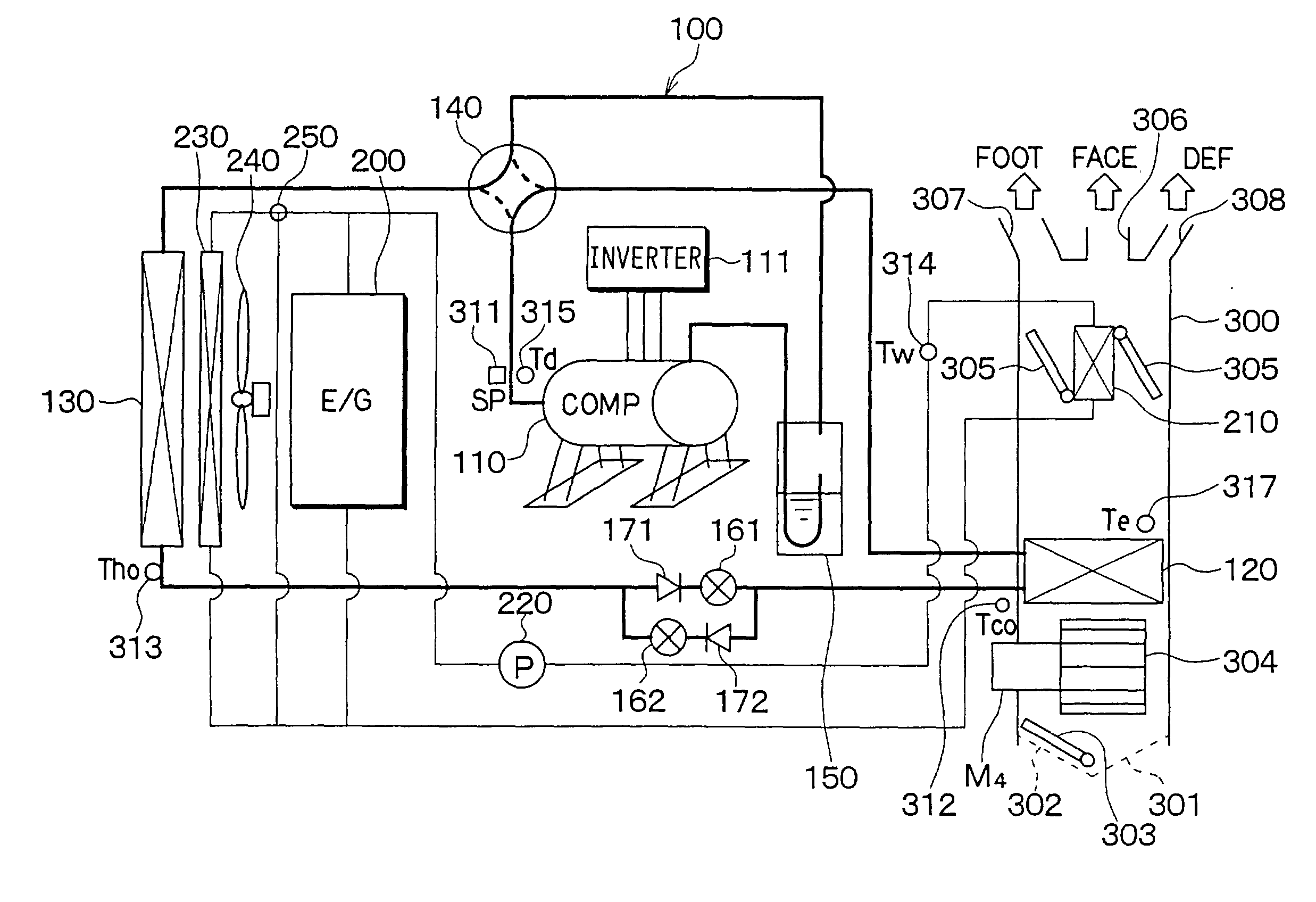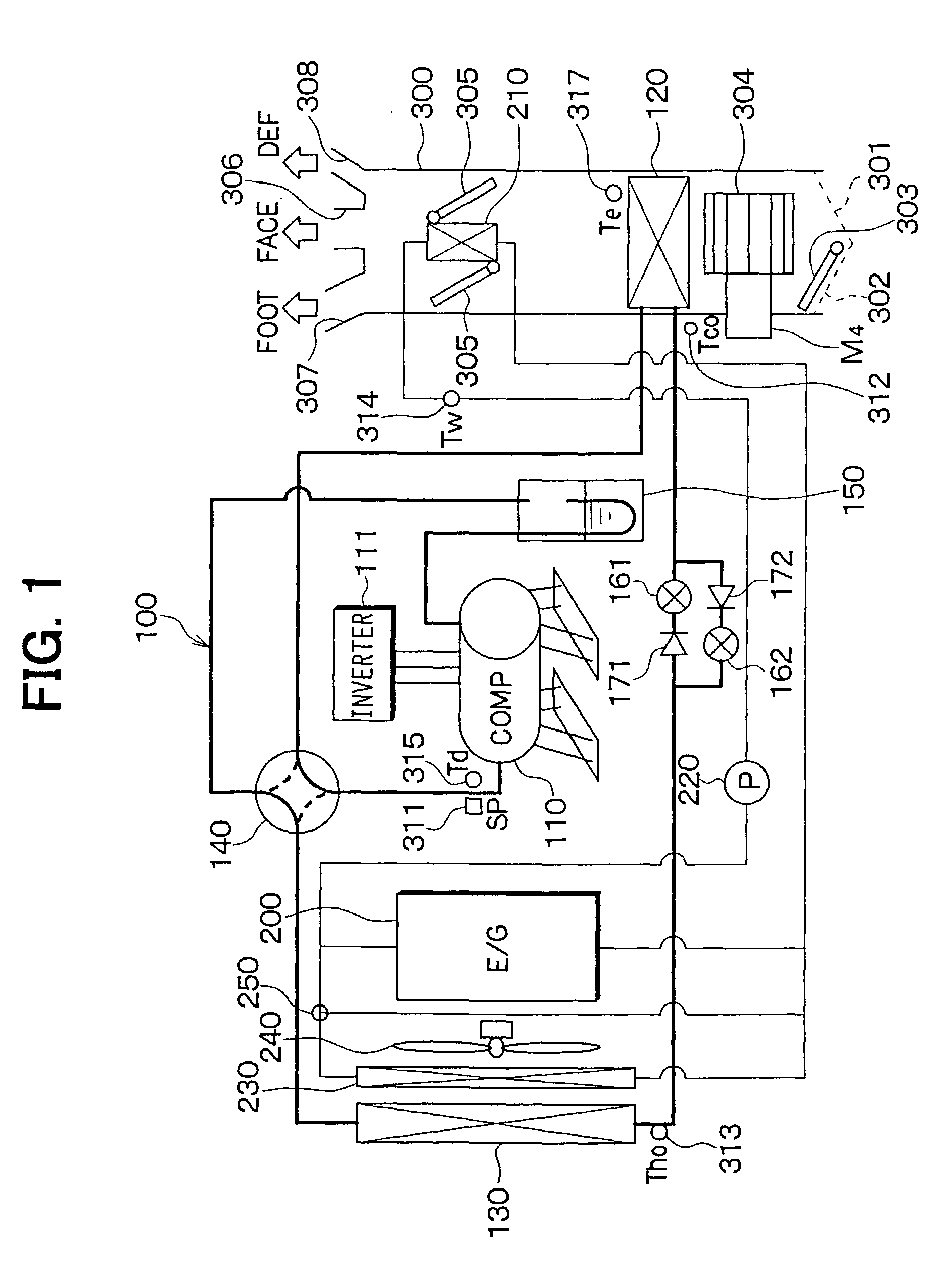Vehicle air conditioner with defrosting operation in exterior heat exchanger
a technology of heat exchanger and vehicle air conditioner, which is applied in the direction of defrosting, heating types, domestic cooling apparatus, etc., can solve the problems of reducing the temperature of air blown into the passenger compartment, unable to obtain the necessary heating capacity, and affecting the operation of the vehicl
- Summary
- Abstract
- Description
- Claims
- Application Information
AI Technical Summary
Benefits of technology
Problems solved by technology
Method used
Image
Examples
first embodiment
[0030] First Embodiment
[0031] In the first embodiment, an air conditioner of the present invention is typically used for a hybrid vehicle driven by electric power of a battery and driving force of an engine. In the vehicle air conditioner shown in FIG. 1, a refrigerant cycle system is constructed by a heat pump cycle 100 capable of switching any one of a cooling operation (defrosting operation) and a heating operation. Further, an engine 200 is disposed for driving the vehicle.
[0032] An electric compressor 110, for sucking and compressing refrigerant, is controlled by an inverter 111. An interior heat exchanger 120 is disposed to perform a heat exchange between refrigerant and air to be blown into a passenger compartment, and an exterior heat exchanger 130 is disposed to perform a heat exchange between the refrigerant and outside air. A four-way valve (switching valve) 140 switches any one of a case where refrigerant discharged from the compressor 110 flows toward the interior heat ...
second embodiment
[0057] Second Embodiment
[0058] In the second embodiment, as shown in FIG. 7, step S125 for determining a fogging state of the windshield is added as compared with FIG. 4 described in the first embodiment. That is, at step S125, it is determined whether or not the windshield tends to be clouded (fogged). Only when it is determined that the windshield is difficult to be fogged at step S125, the heating assist operation (re-heating assist operation) is performed at step S140. That is, the re-heating assist operation is switched from the defrosting operation at a time where it is determined that the windshield is difficult to be fogged. Therefore, even when the blown air is humidified by evaporation of the condensed water due to the heat radiation of the interior heat exchanger 120, it can restrict the windshield from being clouded.
[0059] Here, as a vehicle speed becomes higher, the windshield is readily cooled by the running wind, and the temperature of the windshield becomes lower. Th...
third embodiment
[0060] Third Embodiment
[0061] In the third embodiment, as shown in FIG. 8, step S126 for determining a vehicle stop state is added as compared with FIG. 4 described in the first embodiment. That is, at step S126, it is determined whether or not the vehicle is stopped for a long time longer than a predetermined time. Only when it is determined that the vehicle is stopped for the long time longer than the predetermined time, the heating assist operation (re-heating assist operation) is performed at step S140. For example, the re-heating assist operation is switched from the defrosting operation, when it is determined that the vehicle is stopped for the long time. Therefore, driving safety of the vehicle, due to the fogging of the windshield, can be improved. Specifically, when the ignition switch is turned off, it is determined that the vehicle is stopped for the long time at step S126.
PUM
 Login to View More
Login to View More Abstract
Description
Claims
Application Information
 Login to View More
Login to View More - R&D
- Intellectual Property
- Life Sciences
- Materials
- Tech Scout
- Unparalleled Data Quality
- Higher Quality Content
- 60% Fewer Hallucinations
Browse by: Latest US Patents, China's latest patents, Technical Efficacy Thesaurus, Application Domain, Technology Topic, Popular Technical Reports.
© 2025 PatSnap. All rights reserved.Legal|Privacy policy|Modern Slavery Act Transparency Statement|Sitemap|About US| Contact US: help@patsnap.com



